
14 minute read
Findings Part 1 AT Survey
positive results which may not be perceived as such positive responses when viewed through a larger lens and a more all-encompassing definition of AT.
Findings – Part 1 – AT Survey
GENERAL INFORMATION
1. For which County Board do you work? 2. Which term best describes your role?
The first two survey questions were demographic questions asking which county the individual worked for and their background or role within the agency. All 88 counties responded although some did not complete the entire survey. The survey was sent to superintendents of the 88 CBDDs, but over half passed it on to a representative from their county for survey completion. The role of the individuals who completed the survey are shown in Table 1 below. Table 1 CBDD Staff Role
Superintendent
County Board Staff Member
Other
Speech Language Pathologist
Occupational Therapist
AT Specialist 49% 27% 18% 2% 2% 2%
AWARENESS, ELIGIBILITY, AND ASSESSMENT
Survey questions 3-6 addressed AT awareness, eligibility, and assessment.
3. On a 1 to 10 scale, how well do you think your County Board handles dissemination of
information about assistive technology (AT)? (N=91) Using a 10-point scale, this question asked about how well the County Board disseminates information about AT. The instructions indicated a range from “very badly” which was the lowest rating (1) to “very well” which was the highest rating (10). A little over half of the respondents (52%) indicated they do not do well at distributing information about AT to those they serve.
Figure 1. Staff Disseminates Info About AT.
4. On a 1 to 10 scale, how knowledgeable are your County Board’s staff members about
AT? (N = 91) Of the respondents surveyed 55% of the counties reported their staff members were fairly knowledgeable about AT, thus scoring within the 6-10 range. Forty-five percent (45%) of the respondents scored in the lower group (1-5-range). None of the respondents indicated their staff had no knowledge of AT.
Figure 2. Staff Knowledgeable About AT.
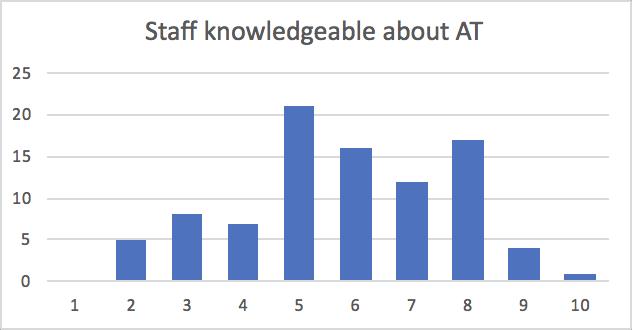

5. Please indicate your level of agreement with the following statements: The County Board disseminates promotional materials about AT.
As shown in Figure 3, half of the respondents felt that the County Board does disseminate information about AT. However, approximately 30% felt that the County Board does not disseminate information about AT and 18% did not know if materials were distributed, likely indicating they did not distribute information about AT.
Figure 3. County Board Disseminates Promotional Materials About AT.
Staff members are aware of a wide variety of AT options.
Comparing responses in Figure 4, the data shows that the majority of the respondents (57%) felt that their staff members were aware of a wide variety of AT options. However, 23% either disagreed or strongly disagreed indicating their confidence in their staff’s awareness of the wide variety of AT may be limited. Another 20% responded with neither agree nor disagree which may indicate they too are unaware of the wide range of AT options available.

Figure 4. Staff Members Aware of AT Options.
Staff members know when an individual is a good candidate for AT.
As seen in Figure 5, because 46% of the respondents either disagreed or said they neither agree nor disagree in response to this question, it becomes apparent that slightly less than half of the CBDDs indicated their staff was unsure about identifying good candidates for AT use.

Figure 5. Staff Members Know Good Candidates for AT.
Assessment of all individuals served by the County Board of DD includes consideration of AT options.
This question asks if AT is being considered for all consumers who receive some sort of assessment through the CBDD system. Slightly less than half (49%) feel as if AT is being considered for all consumers (agree/strongly agree) whereas 24% indicated that AT is not being considered for all consumers (disagree/strongly disagree). Twenty-seven percent (27%) were unable to respond in agreement or disagreement to the statement.

Figure 6. Assessment Includes Consideration of AT Options.
The County Board has a formal process for AT assessment.
Figure 7 shows that disagree/strongly disagree responses are greater (37%) than the agree/strongly agree responses (29%). This data indicates that less than ⅓ of the CBDDs responding to the survey utilize a formal process for AT assessment.

Figure 7. Formal Process for AT Assessment.
A team approach is used when making decisions about AT.
Figure 8 shows that the agree/strongly agree responses are much greater (74%) than the disagree/strongly disagree responses (7%). This strongly indicates that a team approach is being used to make decisions about AT at the majority of CBDDs surveyed.

Figure 8. Team Approach Used for AT Decision.
AT trials are provided prior to purchase.
In response to this question, 34% felt that AT trials are being provided prior to purchase and 26% felt that AT trials were not happening prior to purchase. Only approximately ⅓ of the CBDDs surveyed are employing this aspect of the AT assessment process.
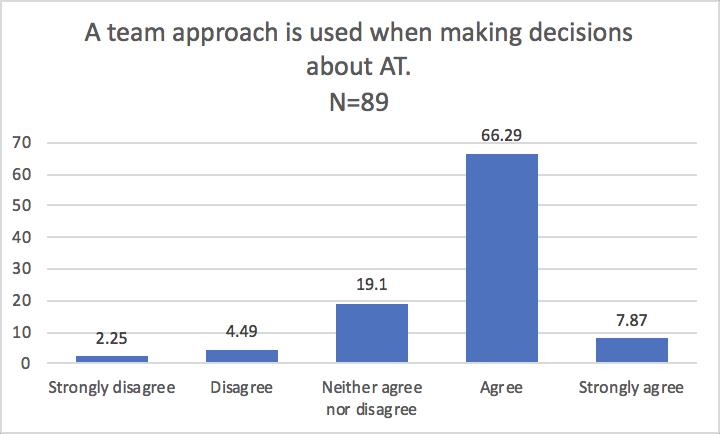
Figure 9. AT Trials Provided Prior to Purchase.
AT recommendations include a range of AT features.
Twenty-one percent (21%) feel that the AT recommendations being generated do not include a wide range of AT features and 38% feel that AT recommendations generated do include a range of AT features. It is noteworthy that 41% of the respondents responded neither agree nor disagree.

Figure 10. AT Recommendations Include a Range of AT Features.
6. Which of the following factors do AT assessment teams typically consider?
● The individual’s strengths and needs ● The environments in which the individual lives, attends school and/or works ● The individual’s previous use of AT ● The tasks the individual wishes to accomplish with the use of AT ● The individual’s personal preferences

Family member’s perspectives The individual’s culture and customs
For this question, the respondents were asked to select “yes” or “no” for each statement. This question considered the CBDD perceptions of the factors assessment teams should consider during the AT assessment process. Overall, it is apparent that the vast majority of CBDDs believe that AT assessment teams should consider all of the following factors. However, previous use of AT and culture and customs are the areas that are most often not considered. The responses to each statement are shown in the Figure 11 below.
Figure 11. Factors Considered by AT Assessment Teams.

IMPLEMENTATION
Questions 7-10 addressed AT implementation planning and AT implementation.
7. On a 1 to 10 scale, how well do you think your County Board handles planning for AT implementation? Give the lowest rating if your County Board does not plan for AT
implementation. (N=89) Questions 7 and 8 are similar, but question 7 asks if the County Board plans for AT implementation and then question 8 asks about the actual AT implementation process. Grouping the responses in to a lower half range (scores between 1-5) and an upper half range (scores between 6-10) we can see that the groupings are fairly similar: 44% in the upper half range and 56% in the lower half range. More than ½ of the responses fell within the lower half range, thus indicating that many CBDDs need further assistance in planning for AT implementation.
Figure 12. Planning for AT Implementation.

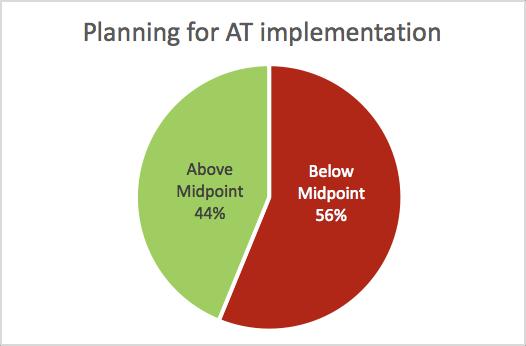
8. On a 1 to 10 scale, how well do you think your County Board handles AT implementation? Give the lowest rating if your County Board does not implement AT.
(N=89) Comparing these graphs to those in Figure 12, a slight increase in the upper half responses (scores between 6-10) is seen. This implies that the CBDDs are doing a slightly better job at actual AT implementation than planning for AT implementation, however, there are still 49% of the CBDDs who did not indicate confidence in their AT implementation skills.
Figure 13. AT Implementation.
9. Which of the following issues are addressed in the AT implementation plan?
● Outcomes to use as benchmarks of the effectiveness of the individual’s AT use ● Considerations about how the device will be financed ● Determinations about who will train the individual using the AT ● Determinations about who will follow-up to ensure the individual is using the
AT effectively
● How personally owned AT will be integrated into the overall set of supports
provided to the individual
For this question, the respondents were asked to select “yes” or “no” for each statement. The responses to each statement are shown in Figure 14. On the whole, those who are using AT seem to be incorporating many aspects of AT implementation. The weakest area is the use of outcomes as benchmarks of the effectiveness of the individual’s use of AT. Identifying specific individuals for follow-up is another area that is commonly overlooked. The other aspects of AT

implementation were heavily weighted toward “yes” responses and are summarized below.
Figure 14. Issues Addressed in the AT Implementation Plan.
10. Please indicate your level of agreement with the following statements. County Board staff assist individuals in the use of AT to achieve identified outcomes.
Sixty-three percent (63%) of the respondents feel their staff does assist individuals in the use of their AT to achieve identified outcomes. However, earlier it was noted that some CBDDs are not identifying the task that needs to be accomplished and some are not using outcomes as benchmarks for AT effectiveness upon implementation. Therefore, some of the disagree/strongly disagree responses here may be a result of the lack of tasks or outcomes being identified.

Figure 15. Individuals Assisted in Use of AT to Achieve Identified Outcomes.

County Board staff collaborates with other agencies and professionals to address challenges that limit an individual’s use of AT.
The vast majority of CBDDs responding felt that they do collaborate (71%) with other agencies and professionals to address challenges of their consumer’s AT use. Only 11% felt their staff did not collaborate with others as indicated in Figure 16.
Figure 16. Collaborate with Other Agencies and Professionals to Address Challenges.
The County Board provides information about device maintenance and repairs (e.g. to individuals, families and caregivers).
There were a greater number of favorable responses (52%) than unfavorable responses (21%). But this data also indicates that at least 21% and perhaps up to 48% (combining the responses from disagree/strongly disagree and neither agree nor disagree) feel that the CBDD does not provide information about maintenance and repairs for AT equipment.

Figure 17. Provides Information About Device Maintenance and Repairs.

The County Board makes a backup system available when an AT device goes in for repair.
The responses were slightly weighted toward those who feel backup systems are not provided (36%) vs. those who feel that backup AT devices are provided (24%) when devices go in for repair. Also to note, the majority of those responding did not have an opinion about whether the Board provides a backup system (neither agree nor disagree: 40%) perhaps indicating that they do not know if that is happening.
Figure 18. A Backup System is Available During AT Repair.
The County Board quickly addresses barriers to AT use.
Figure 19 shows that the majority of the respondents feel the County Board is quickly addressing barriers to AT use (41% vs. 21%). Again, there was a large response for neither agree nor disagree (38%) which may indicate that the responder was unsure of whether barriers are being addressed or it could also mean that the barriers are being addressed, just not quickly.

Figure 19. Barriers to AT Use Are Addressed.

11. On a 1 to 10 scale, how effective is your County Board’s system for evaluating AT use?
Give the lowest rating if your County Board does not evaluate AT at all. (N=86) This question speaks to the follow-up and follow-along aspect of the AT assessment process where the individual’s use of AT is checked periodically to see if it is still meeting the needs of the individual or if changes have occurred and modifications or a reevaluation are needed. Fifty-eight percent (58%) of the responses fell within the lower half range (scores between 1-5) suggesting that the CBDD is not very effective in their efforts to evaluate AT use.
Figure 20. Evaluate AT Use.


12. Which AT evaluation strategies does your County Board routinely use?
● Checking periodically to determine if the AT is meeting the individual’s needs ● Providing a re-evaluation if there are changes to an individual’s needs or
circumstances
● Keeping track of data about the effectiveness of AT use ● Modifying implementation in response to data about the effectiveness of AT
use
● Sharing information about the effectiveness of AT use with the individuals who
are using the AT
● Sharing information about the effectiveness of AT use with other stakeholders
(e.g. County Board staff, families, staff from other agencies)
For this question, the respondents were asked to select “yes” or “no” for each statement. Although many best practice evaluation strategies are being used in the CBDD system, Figure 21 shows weakness in the area of tracking data to show effectiveness of AT provided and also modifying the implementation plan based on data about the effectiveness of use. The individual responses to each statement are shown below.
Figure 21. Evaluation Strategies.
13. High quality training provides a sufficient amount of relevant instruction to all involved stakeholders. Using a 1 to 10 scale, please rate the effectiveness of the AT training your County Board provides. Give the lowest rating if your County Board does
not provide AT training. (N=84) This question seeks to determine the effectiveness of AT training being provided by the CBDD. The scale ranged from 1 = “low quality” to 10 = “high quality”. The highest frequency response was a “1” which indicates the effectiveness of the AT training is “low quality” or the CBDD is not providing AT training. Further analysis indicated that 67% of the responses fell within the lower half range (scores between 1-5) and only 33% fell within the upper half range (scores between 6-10).
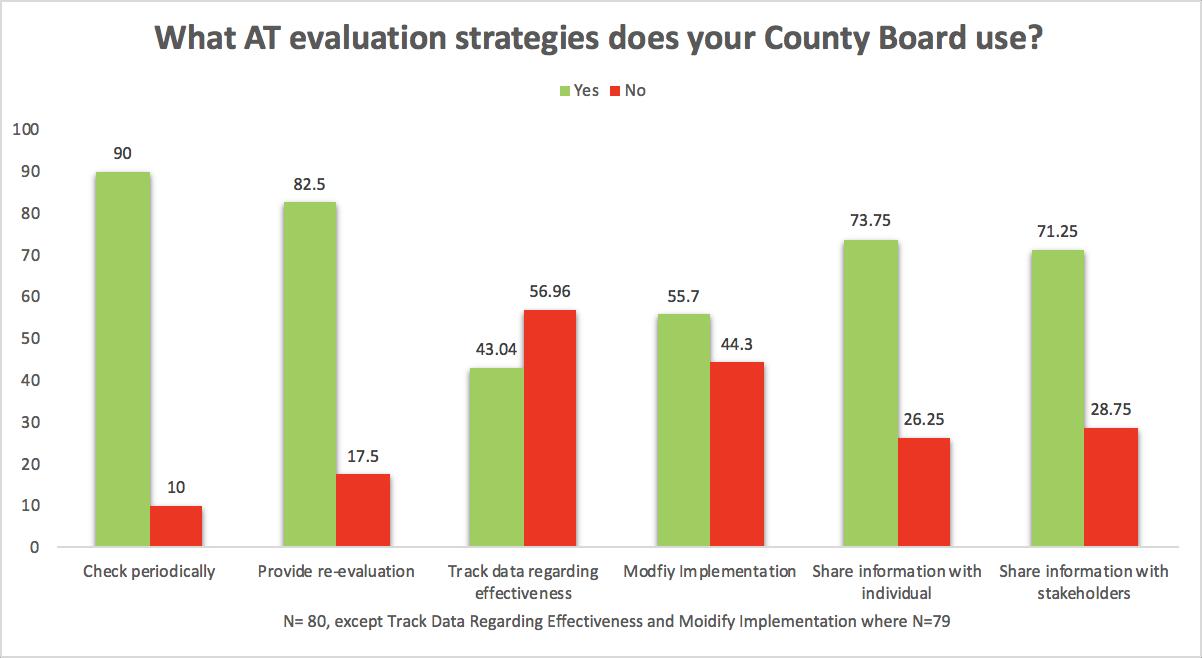
Figure 22. Effectiveness of AT Training.
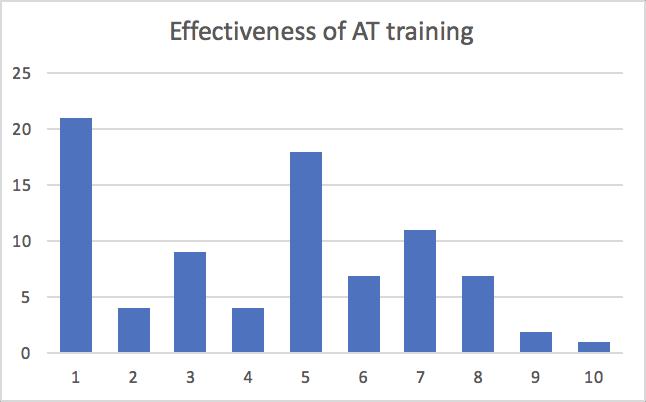
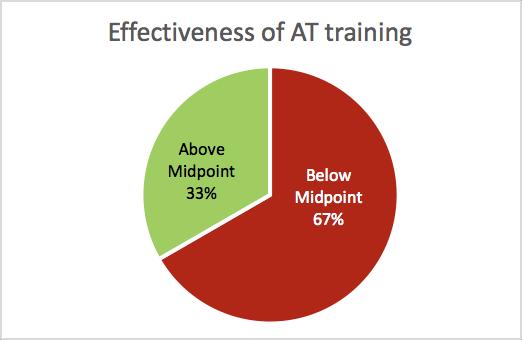
14. An efficient AT funding system draws on all available sources of support (e.g. public funds, private funds, donations) to provide the highest quality AT to clients. It is staffed by personnel who know how to access funds from the full range of sources.
Using a 1 to 10 scale, please rate the efficiency of your County Board’s AT funding
system. (N=84) Forty-six percent (46%) of the responses fell within the upper half range (scores between 6-10) and 54% fell within the lower half range (scores between 1-5) with the greatest frequency occurring at number 5. This data shows the responses are fairly equally distributed with a slightly higher weight given to the lower half responses indicating that the County Board does not always offer an efficient funding system to provide high quality AT for individuals served by the CBDD.
Figure 23. Ability to Acquire AT Funds.
15. AT is central to the mission of a County Board if the Board (1) has written guidelines for accessing and providing AT services that are broadly disseminated and that are followed by all staff members, (2) employs personnel with competencies needed to support quality AT service, and (3) includes AT supports and services in the technology planning and budgeting process. Using a 1 to 10 scale, please rate the extent to which
AT is critical to the mission of your County Board. (N=84) Unfortunately, the results from this question indicate low responses with 70% falling within the lower half range (scores between 1-5) and only 30% within the upper half range (scores between 6-10). Question 15 is overarching question that focuses on the culture and mission of the agency and how embedded AT services and supports are within the entire system framework. It is also a multifaceted question with many parts so perhaps a lower score may be indicated if not all of the variables were true.




